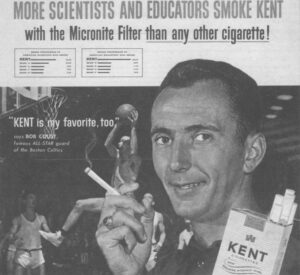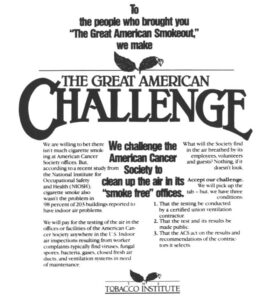Cigarette companies boast of never losing a verdict or paying a penny to settle any of nearly 300 lawsuits filed against them since the 1950s on behalf of dead or dying smokers. Many other producers of unsafe products have not fared so well.
Heavy losses in product liability suits, and the prospect of thousands more settlements or damage awards, drove Manville Corp., the asbestos giant, and A. H. Robins Co., maker of the Dalkon Shield intrauterine devise, into the bankruptcy courts. In dozens of less prominent cases each year, manufacturers of drugs, pesticides, toys, appliances and other products are held liable for injuries to consumers–in some cases to consumers who were partly at fault. There are no firm statistics, but plaintiffs are estimated to win nearly half the product liability suits that go to trial, according to analysts with the Rand Corp.
By sheer numbers, the health toll taken by cigarettes exceeds that from all other consumer products. According to the U.S. Surgeon General, smoking causes more than 300,000 premature deaths annually from cancer, cardiovascular and lung disease–nearly 15% of all fatalities in this country, and more deaths than Americans suffered in World War I, Korea and Vietnam combined.
Writing in the Southern California Law Review, Donald Garner, a law professor at Southern Illinois University, called it “a striking irony…that the industry that markets the most dangerous product sold in America is the only industry that has been completely sheltered from the storm of twentieth-century product liability.”
The contrasting legal fortunes of the tobacco and asbestos industries are especially interesting, since medical studies suggest that most asbestos workers stricken by lung cancer would not have contracted the disease if they hadn’t also smoked.
The flawless record of the tobacco giants extends even to deaths of careless smokers-and innocent bystanders–in residential fires ignited by cigarettes, which are made to keep burning when not being puffed.
Nearly 150 tobacco lawsuits were disposed of during the 1950s and ’60s, according to estimates by industry and plaintiff lawyers. Only about 10 or 15 of these cases actually produced a jury verdict or judicial ruling for the industry. In most other cases, plaintiffs simply gave up, discouraged by unfavorable rulings elsewhere or by the overwhelming legal firepower of the cigarette companies.
But now there is a ‘second wave’ of tobacco lawsuits, one propelled by changes in product liability law, declining social acceptance of smoking, and a growing body of research on the effects of nicotine–called “a powerfully addictive drug” by William Pollin, former director of the National Institute on Drug Abuse. Nearly 150 suits, filed mainly in the last three years, are pending in state and federal courts.
Richard Daynard, a law professor at Northeastern University and head of the Tobacco Products Liability Project–a support group for plaintiff lawyers formed by anti-smoking activists–said it is only a matter of time before verdicts start going to plaintiffs. Although the odds of winning any one of the pending cases is less than half, Daynard contends, the chance of some favorable verdicts is virtually 100%.
Industry lawyers seem equally confident, arguing that time has strengthened their hand by vastly enriching the warnings available to smokers. Sure enough, their victory string has remained unbroken through the first three of the recent cases to go to trial–two cigarette cases and one involving smokeless tobacco. Several other trials are scheduled this summer and fall.
Damage Control
In a sense, the industry’s perfect record is but another measure of its impressive skill at damage control and landing on its feet.
In the realm of public opinion, for example, smoking is still widely viewed as but another ingredient in the hazardous stew of modern living–notwithstanding the Surgeon General’s verdict that it is “the chief, single, avoidable cause of death in our society and the most important public health issue of our time.” Lulled by the lush and reassuring imagery of cigarette ads, people tend to underrate smoking as compared with other hazards-as shown in a Milwaukee Journal poll last year in which respondents were 13 times more likely to choose illicit drugs or alcohol as the leading national health problem than to pick cigarettes.
It’s a similar story in the regulatory arena, despite the recent barrage of state and local restrictions on smoking in public buildings and job sites. These efforts to protect non-smokers from second-hand smoke may make it tougher to be a smoker and so cut down on sales.
Yet cigarette firms have been spared the fate of some other industries whose products the government has deemed unsafe. This country often goes to great lengths to protect its citizens, to the point of evacuating communities threatened by toxic waste, or banning or restricting useful products, like medicines and pesticides, that may have harmful side effects. By contrast, none of the myriad federal health or safety agencies regulates cigarettes, and one–the Consumer Product Safety Commission–in the 1970s was stripped by Congress of jurisdiction over cigarettes to keep it from regulating tar and nicotine levels.
Even the 1965 law requiring a warning label on cigarette packages–superficially a blow struck for public health–arguably did much more for the industry, canceling out a much tougher rule and providing a potent defense against the current round of damage suits.
These suits employ a variety of legal theories, but plaintiffs generally are alleging that the cigarette firms neglected to do health research or provide warnings in the 1930s-50s, when plaintiffs took up smoking, despite growing evidence linking smoking to cancer, heart disease and nicotine dependence; that the warnings eventually placed on cigarette packs did not adequately convey the extent of the risk, failing to explain, for example, that six of every seven lung cancer deaths are attributable to smoking; and that cigarette companies sought to undermine these already inadequate warnings through advertising and unremitting claims that the risks were unproven.
The cigarette companies contend, however, that there still is no scientific proof that smoking causes any disease, much less that a plaintiff can prove his specific illness was caused by his smoking habit. They further argue that smokers, having been made well aware of the claimed risks, are responsible for their decision to smoke.
According to Murray H. Bring, a partner in the powerhouse Washington law firm of Arnold & Porter and national co-counsel for Philip Morris:
“The fundamental issue in all these cases is whether or not a plaintiff who has made a voluntary choice to engage in the practice of smoking, with full awareness of what the alleged risks are, should be permitted to recover damages from a cigarette company, if and when that person develops a disease which he thinks is related to smoking.”
Plaintiffs say the industry is blaming smokers for taking risks the industry denies exist. According to Daynard, this is essentially a “heads-I-win, tails-you-lose defense,” which holds that “one, cigarettes aren’t dangerous; two, anybody who believes us when we say cigarettes aren’t dangerous deserves to die of them.”
Moreover, there is little reason to focus exclusively on the “individual choice” of consumers, the Harvard Law Review suggested in an article last year, since it was the industry’s choice to sell a product considered dangerous by most experts and the ordinary folks who make up jury pools.
According to Bring, however, as long as cigarettes are legal and “there are millions of people who want the product, I don’t think you can say that the companies have done anything improper by manufacturing it.”
A wild-card in this high stakes game are the tens of thousands of company documents obtained by some plaintiff lawyers through the discovery process. Due to claims they contain trade secrets, many of the documents remain sealed under protective orders, and their impact will not be known until release at trial.
Jury reaction to addiction claims could also profoundly affect the outcome of many cases.
Pointing out that 35 million smokers have quit since the first Surgeon General’s report–the vast majority without clinical help–industry lawyers dismiss addiction as an artful ploy to shed the burden of personal choice.
What Addiction Means
“Are juries going to really say smoking is addictive the way heroin is addictive?” asked John Strauch, a Cleveland lawyer coordinating R.J. Reynolds’ defense of the roughly 100 cases, in which it is a defendant. “Or are they going to say, ‘Look, it’s a matter of will power…If someone wants to quit hard enough, they can?’ “
“If they (plaintiffs) are saying that people who smoke cigarettes lose their rational powers to the extent that they can’t…fully appreciate what society has known for many years about the risks of smoking cigarettes, then I don’t think (juries) are going to believe it,” observed George D. Newton, deputy general counsel for RJR Nabisco, Inc., parent company of R. J. Reynolds. Asked if he was conceding it is dangerous to smoke, Newton said he was “conceding that people…are aware of the claimed risks.”

Marc Edell, a lawyer for plaintiffs in eight New Jersey cigarette cases, said the industry is trying to distort “what quote, addiction, closed quote, really means.
“Addiction doesn’t mean that you can’t stop smoking…Addiction doesn’t mean that you can’t stop using cocaine…alcohol…(or) heroin,” Edell said. “All it means is there’s a physiological dependence” that undermines will and judgment.
On the surface, however, the cigarette cases seem tailor-made for an assumption-of-risk defense.
With a warning on every pack for the last 21 years, no smoker can claim he had no inkling of smoking’s hazard. Even earlier, people who never heard of the Surgeon General had heard cigarettes called ‘coffin nails,’ or ‘cancer sticks.’ Starting in the 1950’s the dramatic switch from unfiltered to filtered cigarettes, and later, the demand for low tar brands, is further indication of public awareness.
But plaintiff lawyers think that favorable changes in the legal ground rules along with research supporting nicotine dependence claims, will help overcome the problem of consumer knowledge.
For example, under the rules of strict liability that now prevail in some states, plaintiffs can win without proving negligence or misrepresentation, if they can show that the inherent risks of a product outweigh its social utility.
More important, showing that the injured party was dumb or careless no longer automatically absolves the manufacturer. Under current rules of comparative fault, a manufacturer determined to be at least half responsible is liable for damages proportional to his share of blame. In about 10 states with ‘pure’ comparative fault, a plaintiff whose injury is largely self-inflicted could still win damages in proportion to the manufacturer’s limited responsibility.
But industry lawyers argue that the most profound shift in the legal landscape–the 1965 Cigarette Labeling and Advertising Act–is overwhelmingly in their favor. The law not only should persuade juries that smokers were adequately warned, industry lawyers say. They contend it actually preempts arguments to the contrary, requiring dismissal of any claims that warnings were inadequate or that the companies sought to negate them. Should this preemption defense be generally upheld–as it has been in some individual cases–portions of many lawsuits would be thrown out and plaintiffs would be deprived of arguments central to their case.
The preemption defense holds that the labeling act, as stated in its policy language, was passed so consumers would be “adequately informed” about the risks of smoking. Since Congress said it was adopting a warning that would be adequate, damage claims alleging inadequate warnings should be barred as a matter of law.
Furthermore, the industry argues, Congress sought uniformity, explicitly barring states and cities from requiring different warning labels. If juries, acting under product liability laws of their states, were to award damages for lack of adequate warnings, the companies would be ‘required’ to improve the warning to avoid further liability, contrary to the dictates of Congress.
Plaintiffs, on the other hand, point out that Congress could have explicitly barred private lawsuits but chose not to. Moreover, they say, if the industry felt obliged to give consumers better warnings, it could do this without tinkering with the wording on the pack.
To one central figure in the history of the labeling act, there is deep irony in the preemption defense, given the industry’s role in shaping the bill and ramming it through.
The industry “basically wrote the statute,” said Michael Pertschuk, former chairman of the Federal Trade Commission, who as a young staff member for the Senate Commerce Committee worked on drafting the law.
The year before, the Surgeon General had issued the landmark verdict on smoking as a cause of lung cancer. Also in 1964, the Federal Trade Commission adopted a much stronger labeling rule that had not yet taken effect. Instead of the rather mild and equivocal warning established by Congress (“Caution: Cigarette Smoking May Be Hazardous to Your Health”), the FTC would have required that smokers be informed that “Cigarette Smoking is Dangerous to Health and May Cause Death from Cancer and Other Diseases,” on all cigarette packs and advertising. Lobbied masterfully by the industry, Congress nullified the stronger rule by adopting its own, and forbade the FTC from regulating cigarette advertising for six more years.
“Anyone who understands the politics of tobacco has to know that no warning could ever come out of Congress that was ‘adequate,’ ” Pertschuk said in a recent interview. “By any real assessment of what was going on, Congress was essentially doing the minimum that it felt it had to do in order to avoid disgrace,” Pertschuk said.
Even so, according to Pertschuk, “there was never any thought…[on] the part of any of those involved in Congress to affect private litigation.”
The final verdict on preemption may come from the Supreme Court. Some lower courts have ruled for the industry, and others for plaintiffs, with the inevitable drawn-out appeals by the losing side.
The highest court to decide the issue, the U.S. Court of Appeals for the 3rd Circuit, last year sided with the industry, reversing a lower court decision that would have allowed lawyers for the estate of Rose Cippolone, a New Jersey woman who died of lung cancer, to try to persuade a jury that warnings she got were inadequate and were negated by industry advertising and attacks on health evidence.
Then last December, in an opinion tinged with bitterness, the federal district judge who was reversed by the 3rd Circuit applied the higher court’s decision by dismissing several counts of the Cippolone complaint.
According to Judge H. Lee Sarokin, the higher court’s ruling would allow cigarette firms to “deceive and mislead” consumers, so long as they faithfully applied the warning label required by Congress at any given time.
“It is ironic that…deceiving the consuming public and concealing the truth from it is deemed to be an activity which Congress implied intendedly to protect in enacting this legislation,” Sarokin wrote.
“In essence, without any express authority from Congress, a single industry, for the first time in our country’s history, may speak what is untrue, may conceal what is true, and may avoid liability for doing so merely by affixing certain mandated warnings to its products and advertising.”
If the preemption defense is upheld, many of the lawsuits will quietly disappear, industry lawyers believe. Plaintiff lawyers say verdicts eventually will start going their way, even if they lose on preemption.
Anti-smoking groups hope that victories by plaintiffs would turn the current mild slump in cigarette sales into a giddy plunge.
Although the proportion of adult Americans who smoke has long been in decline, and now is about 30%, total sales continued to rise with population growth and heavier consumption by the average smoker. During the last two years however, domestic consumption actually declined to 583 billion cigarettes in 1986, a huge number but still the lowest total since 1972.
Daynard thinks a few plaintiff victories would set off a tidal wave of claims, further eroding social acceptance of smoking and emboldening advocates of non-smokers’ rights. The costs of legal defense and damage awards, Daynard believes, eventually would drive the cost of a pack of cigarettes to $4, keeping teenagers from starting and causing all but die-hards to quit.
Calvert Crary, a litigation analyst with the investment firm of Bear, Stearns, & Co., Inc., also thinks the impact could be great, but that there would be no drastic price increase due to the depth of the industry’s pockets. Retail sales of cigarettes are nearly $30 billion per year, producing a cash flow so huge that “a minor price increase could easily recoup whatever damages could conceivably be awarded by the court system,” Crary said.
But if courts held the industry liable for the deaths of consumers, Crary said, this would “accelerate the pace of social and regulatory change.”
Industry lawyers say society itself would be the loser if the tide turns against them. For if smokers force cigarette companies to insure them against their choices, won’t consumers of butter and red meat and alcohol try the same thing?
Should plaintiffs prevail, according to an industry brief in a Tennessee case, “the flood of products liability litigation that could ensue would overwhelm the judicial system,” destroying “the principles of freedom of choice and personal responsibility.”
Bring, the lawyer for Philip Morris, is more prosaic about the impact of adverse verdicts.
“We’d probably have to defend a lot more (lawsuits) than we do now,” he mused. “We still go on defending them because I think even if we lost a few, we’d continue to win the vast majority.”
Cigarette companies “would have to hire more lawyers, I guess,” Bring went on. “They’d probably replace some that they already had.”
©1987 Myron Levin
Myron Levin, a reporter on leave from the Los Angeles Times, is reporting on the tobacco industry.




